Hybrid Genetic Algorithm−Based BP Neural Network Models Optimize Estimation Performance of Reference Crop Evapotranspiration in China
Abstract
1. Introduction
2. Materials and Methods
2.1. Study Area
2.2. Data Collection and Analysis
2.3. Models for Estimating Reference Crop Evapotranspiration
2.3.1. FAO Penman–Monteith Model
2.3.2. BP Neural Network Model
2.3.3. Genetic Algorithm Optimized BP Neural Network Model
2.4. Input Variables Selection
2.5. Model Accuracy Evaluation
3. Results
3.1. Correlation Analysis between ET0 and Meteorological Factors
3.2. Comparison of Statistical Indices of BP and GABP Models
3.3. Comparison of Seasonal ET0 Estimates from FAO PM Equation, BP and GABP Models
3.4. Result Analysis
4. Discussion
4.1. Contribution of Meteorological Factors to ET0 Variations
4.2. Seasonal and Climatic Effects on ET0 Estimation
4.3. Genetic Algorithm Improves the Performance of Models
5. Conclusions
Supplementary Materials
Author Contributions
Funding
Data Availability Statement
Acknowledgments
Conflicts of Interest
References
- Dold, C.; Heitman, J.; Giese, G.; Howard, A.; Havlin, J.; Sauer, T. Upscaling evapotranspiration with parsimonious models in a North Carolina Vineyard. Agronomy 2019, 9, 152. [Google Scholar] [CrossRef]
- Kumar, N.; Adeloye, A.; Shankar, V.; Rustum, R. Neural computing modelling of the crop water stress index. Agric. Water Manag. 2020, 239, 106259. [Google Scholar] [CrossRef]
- Chia, M.; Huang, Y.; Koo, C. Support vector machine enhanced empirical reference evapotranspiration estimation with limited meteorological parameters. Comput. Electron. Agric. 2020, 175, 105577. [Google Scholar] [CrossRef]
- Valiantzas, J. Simplified limited data Penman’s ET0 formulas adapted for humid locations. J. Hydrol. 2015, 524, 701–707. [Google Scholar] [CrossRef]
- Fan, J.; Wang, X.; Wu, L.; Zhou, H.; Zhang, F.; Yu, X.; Lu, X.; Xiang, Y. Comparison of support vector machine and extreme gradient boosting for predicting daily global solar radiation using temperature and precipitation in humid subtropical climates: A case study in China. Energy Convers. Manag. 2018, 164, 102–111. [Google Scholar] [CrossRef]
- Mehdizadeh, S.; Behmanesh, J.; Khalili, K. Using MARS, SVM, GEP and empirical equations for estimation of monthly mean reference evapotranspiration. Comput. Electron. Agric. 2017, 139, 103–114. [Google Scholar] [CrossRef]
- Fan, J.; Wu, L.; Zhang, F.; Cai, H.; Ma, X.; Bai, H. Evaluation and development of empirical models for estimating daily and monthly mean daily diffuse horizontal solar radiation for different climatic regions of China. Renew. Sustain. Energy Rev. 2019, 105, 168–186. [Google Scholar] [CrossRef]
- Patil, A.; Deka, P. Performance evaluation of hybrid Wavelet-ANN and Wavelet-ANFIS models for estimating evapotranspiration in arid regions of India. Neural Comput. Appl. 2015, 28, 275–285. [Google Scholar] [CrossRef]
- Tabari, H. Evaluation of reference crop evapotranspiration equations in various climates. Water Resour. Manag. 2010, 24, 2311–2337. [Google Scholar] [CrossRef]
- Saggi, M.; Jain, S. Reference evapotranspiration estimation and modeling of the Punjab Northern India using deep learning. Comput. Electron. Agric. 2019, 156, 387–398. [Google Scholar] [CrossRef]
- Antonopoulos, V.; Antonopoulos, A. Daily reference evapotranspiration estimates by artifcial neural networks technique and empirical equations using limited input climate variables. Comput. Electron. Agric. 2017, 132, 86–96. [Google Scholar] [CrossRef]
- Elbeltagi, A.; Nagy, A.; Mohammed, S.; Pande, C.; Kumar, M.; Bhat, S.; Zsembeli, J.; Huzsvai, L.; Tamás, J.; Kovács, E.; et al. Combination of limited meteorological data for predicting reference crop evapotranspiration using artificial neural network method. Agronomy 2022, 12, 516. [Google Scholar] [CrossRef]
- Dimitriadou, S.; Nikolakopoulos, K. Artificial neural networks for the prediction of the reference evapotranspiration of the Peloponnese Peninsula, Greece. Water 2022, 14, 2027. [Google Scholar] [CrossRef]
- Ferreira, L.; Cunha, F.; Oliveira, R.; Fernandes Filho, E. Estimation of reference evapotranspiration in Brazil with limited meteorological data using ANN and SVM—A new approach. J. Hydrol. 2019, 572, 556–570. [Google Scholar] [CrossRef]
- Falamarzi, Y.; Palizdan, N.; Feng, Y.; Shui, T. Estimating evapotranspiration from temperature and wind speed data using artificial and wavelet neural networks (WNNs). Agric. Water Manag. 2014, 140, 26–36. [Google Scholar] [CrossRef]
- Chen, Z.; Zhu, Z.; Jiang, H.; Sun, S. Estimating daily reference evapotranspiration based on limited meteorological data using deep learning and classical machine learning methods. J. Hydrol. 2020, 591, 125286. [Google Scholar] [CrossRef]
- Jiao, P.; Hu, S. Optimal alternative for quantifying reference evapotranspiration in Northern Xinjiang. Water 2022, 14, 1. [Google Scholar] [CrossRef]
- Granata, F. Evapotranspiration evaluation models based on machine learning algorithms–A comparative study. Agric. Water Manag. 2019, 217, 303–315. [Google Scholar] [CrossRef]
- Patil, A.; Deka, P. An extreme learning machine approach for modeling evapotranspiration using extrinsic inputs. Comput. Electron. Agric. 2016, 121, 385–392. [Google Scholar] [CrossRef]
- Meenal, R.; Selvakumar, A. Assessment of SVM, empirical and ANN based solar radiation prediction models with most influencing input parameters. Renew. Energy 2018, 121, 324–343. [Google Scholar] [CrossRef]
- Xu, T.; Guo, Z.; Xia, Y.; Ferreira, V.; Liu, S.; Wang, K.; Yao, Y.; Zhang, X.; Zhao, C. Evaluation of twelve evapotranspiration products from machine learning, remote sensing and land surface models over conterminous United States. J. Hydrol. 2019, 578, 124105. [Google Scholar] [CrossRef]
- Nourani, V.; Elkiran, G.; Abdullahi, J. Multi-station artificial intelligence based ensemble modeling of reference evapotranspiration using pan evaporation measurements. J. Hydrol. 2019, 577, 123958. [Google Scholar] [CrossRef]
- Fan, J.; Yue, W.; Wu, L.; Zhang, F.; Cai, H.; Wang, X.; Lu, X.; Xiang, Y. Evaluation of SVM, ELM and four tree-based ensemble models for predicting daily reference evapotranspiration using limited meteorological data in different climates of China. Agr. For. Meteorol. 2018, 263, 225–241. [Google Scholar] [CrossRef]
- Yang, Y.; Cui, Y.; Bai, K.; Luo, T.; Dai, J.; Wang, W.; Luo, Y. Short-term forecasting of daily reference evapotranspiration using the reduced–set Penman–Monteith model and public weather forecasts. Agric. Water Manag. 2019, 211, 70–80. [Google Scholar] [CrossRef]
- Kim, N.; Kim, K.; Lee, S.; Cho, J.; Lee, Y. Retrieval of daily reference evapotranspiration for croplands in South Korea using machine learning with satellite images and numerical weather prediction data. Remote Sens. 2020, 12, 3642. [Google Scholar] [CrossRef]
- Chen, S.; Li, M.; Chen, L.; Yang, Z.; Sun, K. Monthly reference crop evapotranspiration estimation model based on air temperature and DC-BP-NN in Hexi corridor. Trans. Chin. Soc. Agric. Mach. 2015, 46, 140–147, (In Chinese with English Abstract). [Google Scholar]
- Zhang, Q.; Duan, A.; Gao, Y.; Shen, X.; Cai, H. Analysis of reference evapotranspiration estimation methods using temperature data. Trans. Chin. Soc. Agric. Mach. 2015, 46, 104–109, (In Chinese with English Abstract). [Google Scholar]
- Gong, D.; Hao, W.; Gao, L.; Feng, Y.; Cui, N. Extreme learning machine for reference crop evapotranspiration estimation: Model optimization and spatiotemporal assessment across different climates in China. Comput. Electron. Agric. 2021, 187, 106294. [Google Scholar] [CrossRef]
- Kim, S.; Kim, H. Neural networks and genetic algorithm approach for nonlinear evaporation and evapotranspiration modeling. J. Hydrol. 2008, 351, 299–317. [Google Scholar] [CrossRef]
- Liu, Q.; Wu, Z.; Cui, N.; Zhang, W.; Wang, Y.; Hu, X.; Gong, D.; Zheng, S. Genetic algorithm–optimized extreme learning machine model for estimating daily reference evapotranspiration in Southwest China. Atmosphere 2022, 13, 971. [Google Scholar] [CrossRef]
- Zhang, Z.; Zeng, X.; Li, G.; Lu, B.; Xiao, M.; Wang, B. Summer precipitation forecast using an optimized artificial neural network with a genetic algorithm for Yangtze–Huaihe River Basin, China. Atmosphere 2022, 13, 929. [Google Scholar] [CrossRef]
- Liu, B.; Liu, M.; Cui, Y.; Shao, D.; Mao, Z.; Zhang, L.; Khan, S.; Luo, Y. Assessing forecasting performance of daily reference evapotranspiration using public weather forecast and numerical weather prediction. J. Hydrol. 2020, 590, 125547. [Google Scholar] [CrossRef]
- Tsakiri, K.; Marsellos, A.; Kapetanakis, S. Artificial neural network and multiple linear regression for flood prediction in Mohawk River, New York. Water 2018, 10, 1158. [Google Scholar] [CrossRef]
- Salem, H.; Attiya, G.; El-Fishawy, N. Intelligent decision support system for breast cancer diagnosis by gene expression profiles. In Proceedings of the 2016 33rd National Radio Science Conference (NRSC), Aswan, Egypt, 22–25 February 2016; pp. 421–430. [Google Scholar]
- Yan, B.; Yan, C.; Long, F.; Tan, X. Multi–objective optimization of electronic product goods location assignment in stereoscopic warehouse based on adaptive genetic algorithm. J. Intell. Manuf. 2016, 29, 1273–1285. [Google Scholar] [CrossRef]
- Atlam, M.; Torkey, H.; Salem, H.; El-Fishawy, N. A new feature selection method for enhancing cancer diagnosis based on DNA microarray. In Proceedings of the 2020 37th National Radio Science Conference (NRSC), Cairo, Egypt, 8–10 September 2020; pp. 285–295. [Google Scholar]
- Qiu, R.; Liu, C.; Cui, N.; Wu, Y.; Wang, Z.; Li, G. Evapotranspiration estimation using a modified Priestley–Taylor model in a rice–wheat rotation system. Agric. Water Manag. 2019, 224, 105755. [Google Scholar] [CrossRef]
- Priestley, C.; Taylor, R. On the assessment of surface heat flux and evaporation using large–scale parameters. Mon. Weather Rev. 1972, 100, 81–92. [Google Scholar] [CrossRef]
- Despotovic, M.; Nedic, V.; Despotovic, D.; Cvetanovic, S. Review and statistical analysis of different global solar radiation sunshine models. Renew. Sustain. Energy Rev. 2015, 52, 1869–1880. [Google Scholar] [CrossRef]
- Traore, S.; Luo, Y.; Fipps, G. Deployment of artificial neural network for short-term forecasting of evapotranspiration using public weather forecast restricted messages. Agric. Water Manag. 2016, 163, 363–379. [Google Scholar] [CrossRef]
- Hassan, G.; Youssef, M.; Mohamed, Z.; Ali, M.; Hanafy, A. New temperature-based models for predicting global solar radiation. Appl. Energy 2016, 179, 437–450. [Google Scholar] [CrossRef]
- Zhai, W.; Dai, M.; Cai, W.; Wang, Y.; Hong, H. The partial pressure of carbon dioxide and air–sea fluxes in the northern South China Sea in spring, summer and autumn. Mar. Chem. 2005, 96, 87–97. [Google Scholar] [CrossRef]
- Paredes, P.; Pereira, L. Computing FAO56 reference grass evapotranspiration PM–ET0 from temperature with focus on solar radiation. Agric. Water Manag. 2019, 215, 86–102. [Google Scholar] [CrossRef]
- Samani, Z. Estimating solar radiation and evapotranspiration using minimum climatological data. J. Irrig. Drain. Eng. 2000, 126, 265–267. [Google Scholar] [CrossRef]
- Marino, M.; Tracy, J.; Taghavi, S. Forecasting of reference crop evapotranspiration. Agric. Water Manag. 1993, 24, 163–187. [Google Scholar] [CrossRef]
- Traore, S.; Wang, Y.; Kerh, T. Artificial neural network for modeling reference evapotranspiration complex process in Sudano–Sahelian zone. Agric. Water Manag. 2010, 97, 707–714. [Google Scholar] [CrossRef]
- Shahid, F.; Zameer, A.; Muneeb, M. A novel genetic LSTM model for wind power forecast. Energy 2021, 223, 120069. [Google Scholar] [CrossRef]
- Shao, B.; Song, D.; Bian, G.; Zhao, Y.; Liu, W. Wind speed forecast based on the LSTM neural network optimized by the firework algorithm. Adv. Mater. Sci. Eng. 2021, 2021, 4874757. [Google Scholar] [CrossRef]
- Kisi, O. Modeling reference evapotranspiration using three different heuristic regression approaches. Agric. Water Manag. 2016, 169, 162–172. [Google Scholar] [CrossRef]
- Huang, G.; Wu, L.; Ma, X.; Zhang, W.; Fan, J.; Yu, X.; Zeng, W.; Zhou, H. Evaluation of CatBoost method for prediction of reference evapotranspiration in humid regions. J. Hydrol. 2019, 574, 1029–1041. [Google Scholar] [CrossRef]
- Ren, X.; Qu, Z.; Martins, D.; Paredes, P.; Pereira, L. Daily reference evapotranspiration for hyper–arid to moist sub–humid climates in Inner Mongolia, China: I. Assessing temperature methods and spatial variability. Water Resour. Manag. 2016, 30, 3769–3791. [Google Scholar] [CrossRef]
- Wu, H. Prediction of Reference Crop Evapotranspiration Based on Back Propagation Network. Master’s Thesis, Hohai University, Nanjing, China, 5 June 2006; pp. 42–48, (In Chinese with English Abstract). [Google Scholar]
- Ren, Y. Crop Water Requirements Model Based on Back Propagation Neural Network and IoT. Master’s Thesis, Kunming University of Science and Technology, Kunming, China, 16 May 2021; pp. 21–26, (In Chinese with English Abstract). [Google Scholar]
- Li, Y.; Lv, M.; Zhang, W.; Deng, Z.; Liu, C.; Jiang, M. Sensitivity Analysis of the Reference Crop Evapotranspiration to Meteorological Factors. J. Irrig. Drain. 2017, 36, 94–99, (In Chinese with English Abstract). [Google Scholar]
- Liu, Y.; Zhao, W.; Yang, P.; Ma, X.; Zhang, L. Reference Evapotranspiration Estimation Model Based on Temperature and Humidity. J. Irrig. Drain. 2016, 35, 35–39, (In Chinese with English Abstract). [Google Scholar]
- Zhang, Y. Change in ET0 and the model to estimate it: A case study for Xinxiang. J. Irrig. Drain. 2019, 38, 116–122, (In Chinese with English Abstract). [Google Scholar]
- Paredes, P.; Pereira, L.; Almorox, J.; Darouich, H. Reference grass evapotranspiration with reduced datasets: Parameterization of the FAO Penman–Monteith temperature approach and the Hargeaves–Samani equation using local climatic variables. Agric. Water Manag. 2020, 240, 106210. [Google Scholar] [CrossRef]
- Qiu, R.; Katul, G.; Wang, J.; Xu, J.; Kang, S.; Liu, C.; Zhang, B.; Li, L.; Cajucom, E. Differential response of rice evapotranspiration to varying patterns of warming. Agr. For. Meteorol. 2021, 298–299, 108293. [Google Scholar] [CrossRef]
- Quej, V.; Almorox, J.; Arnaldo, J.; Saito, L. ANFIS, SVM and ANN soft–computing techniques to estimate daily global solar radiation in a warm sub–humid environment. J. Atmos. Sol. Terr. Phys. 2017, 155, 62–70. [Google Scholar] [CrossRef]
- Momeni, E.; Nazir, R.; Armaghani, D.; Maizir, H. Prediction of pile bearing capacity using a hybrid genetic algorithm–based ANN. Measurement 2014, 57, 122–131. [Google Scholar] [CrossRef]
- Huang, R.; Li, Z.; Cao, B. A soft sensor approach based on an echo state network optimized by improved genetic algorithm. Sensors 2020, 20, 5000. [Google Scholar] [CrossRef]
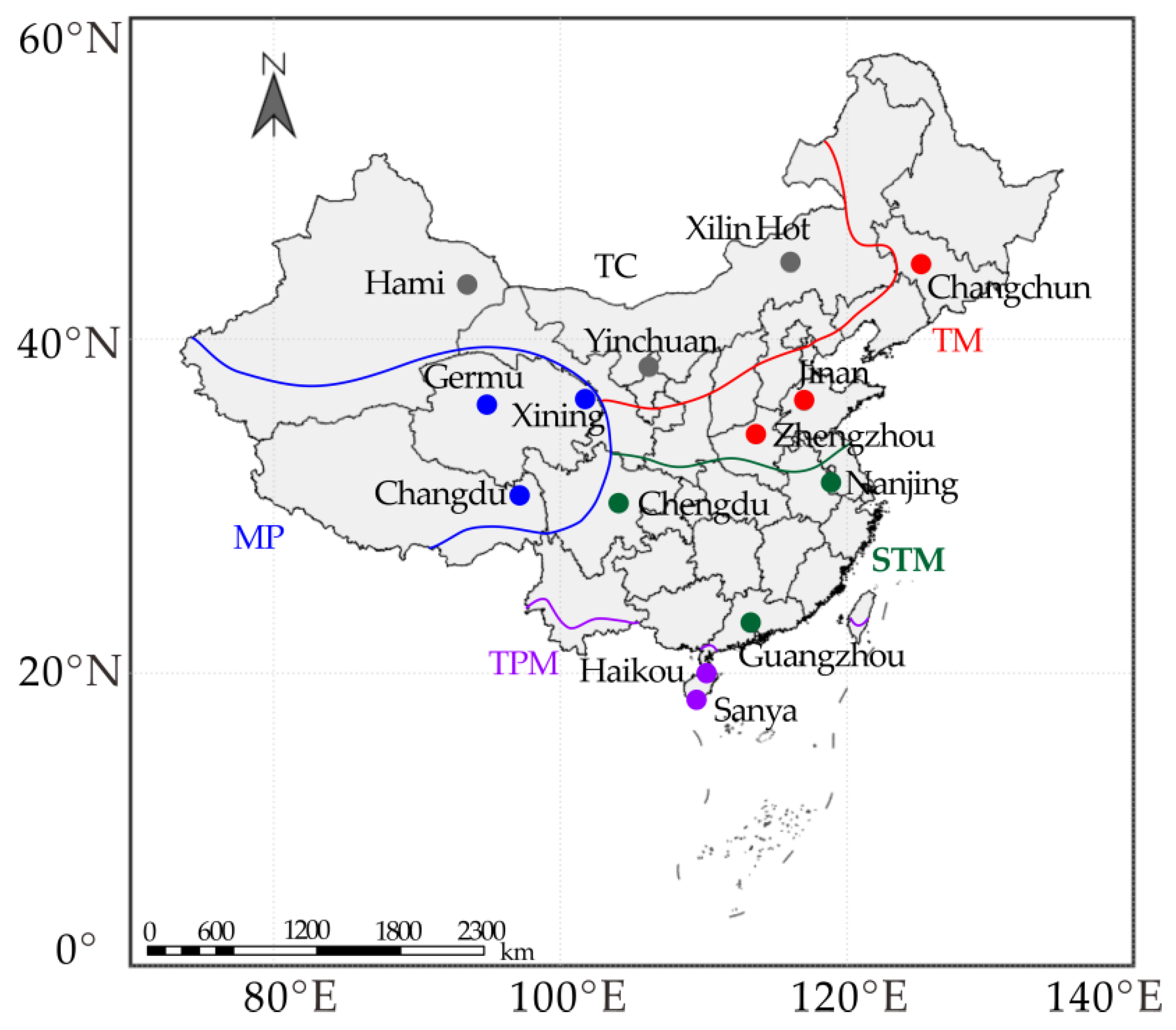
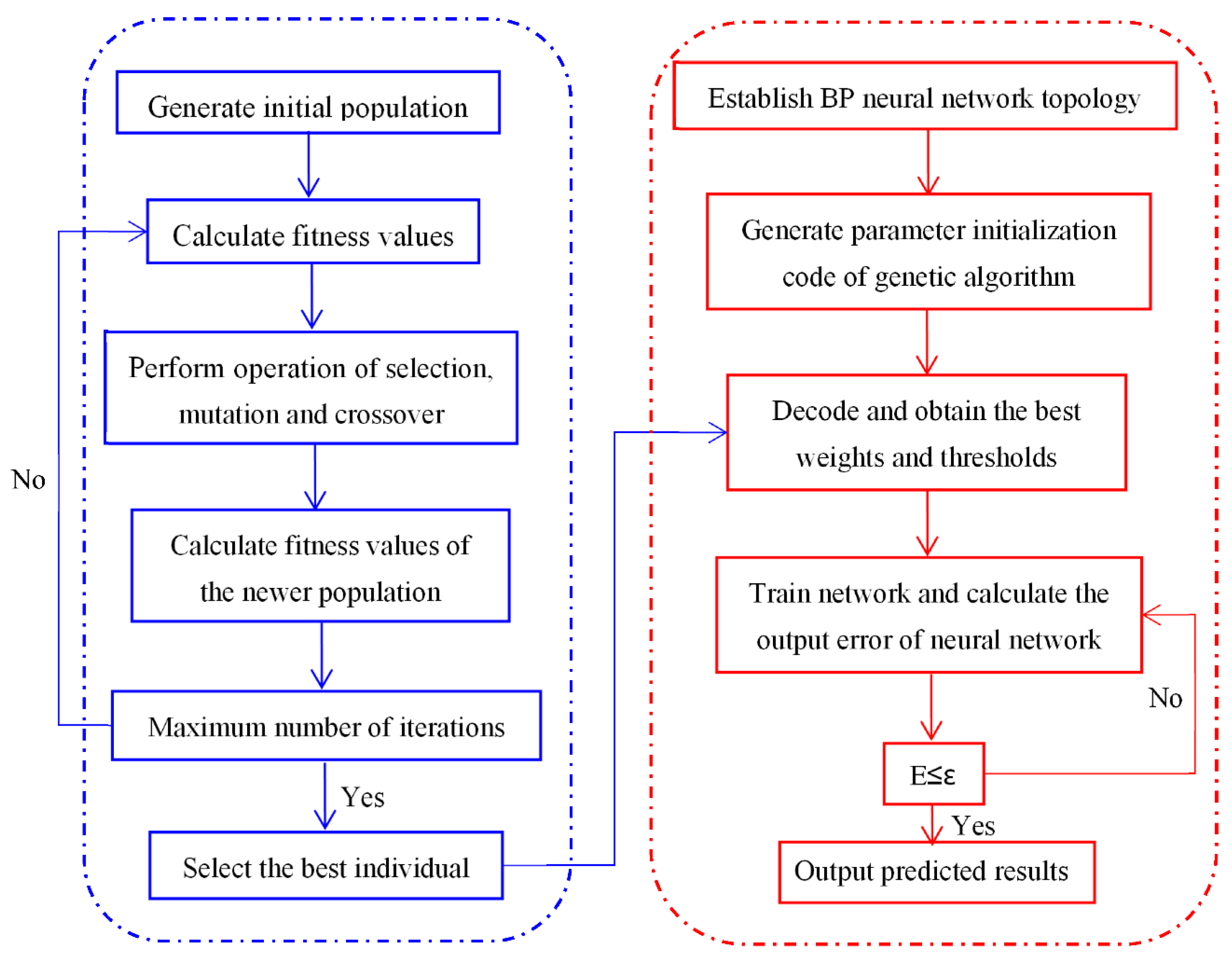

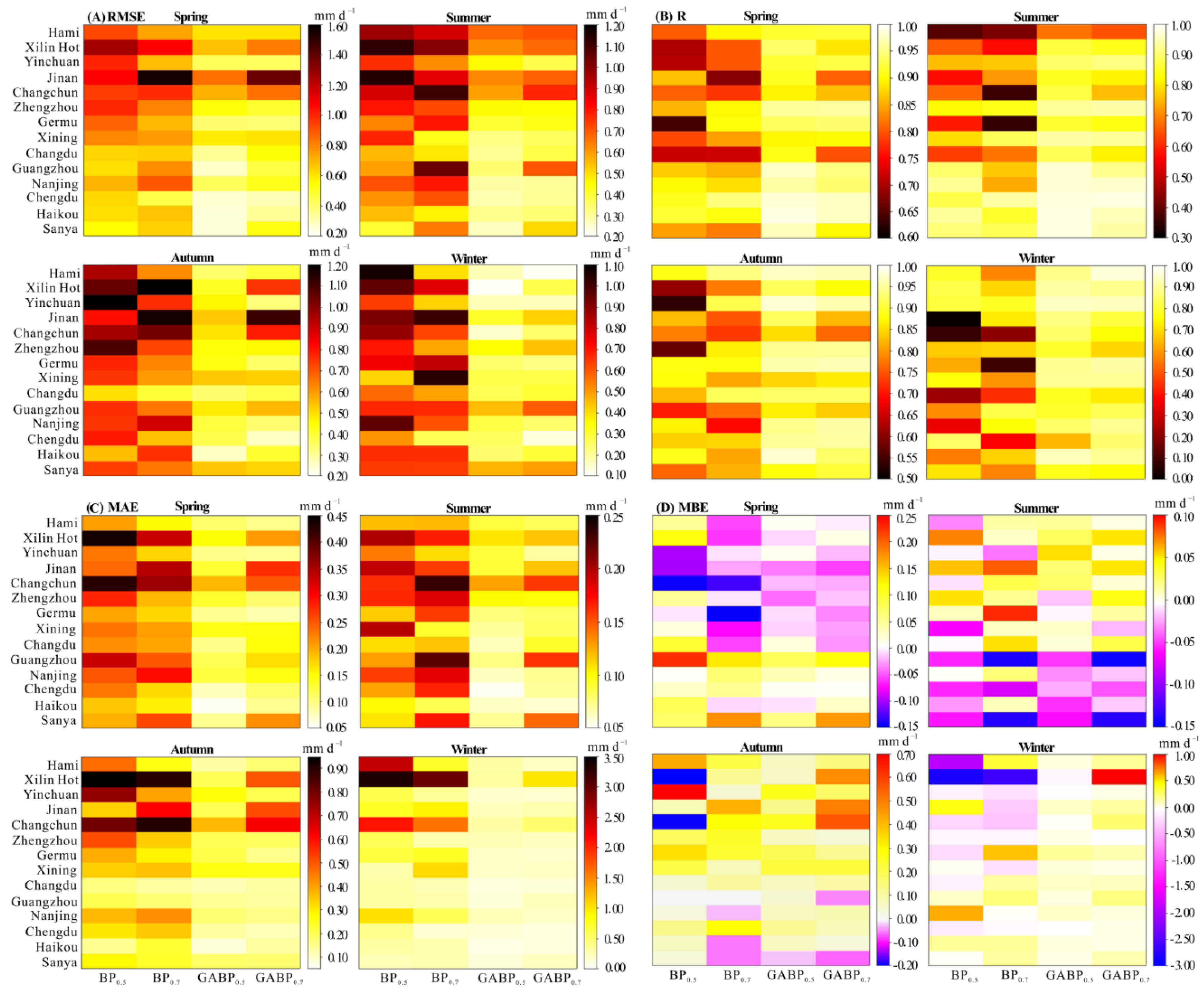
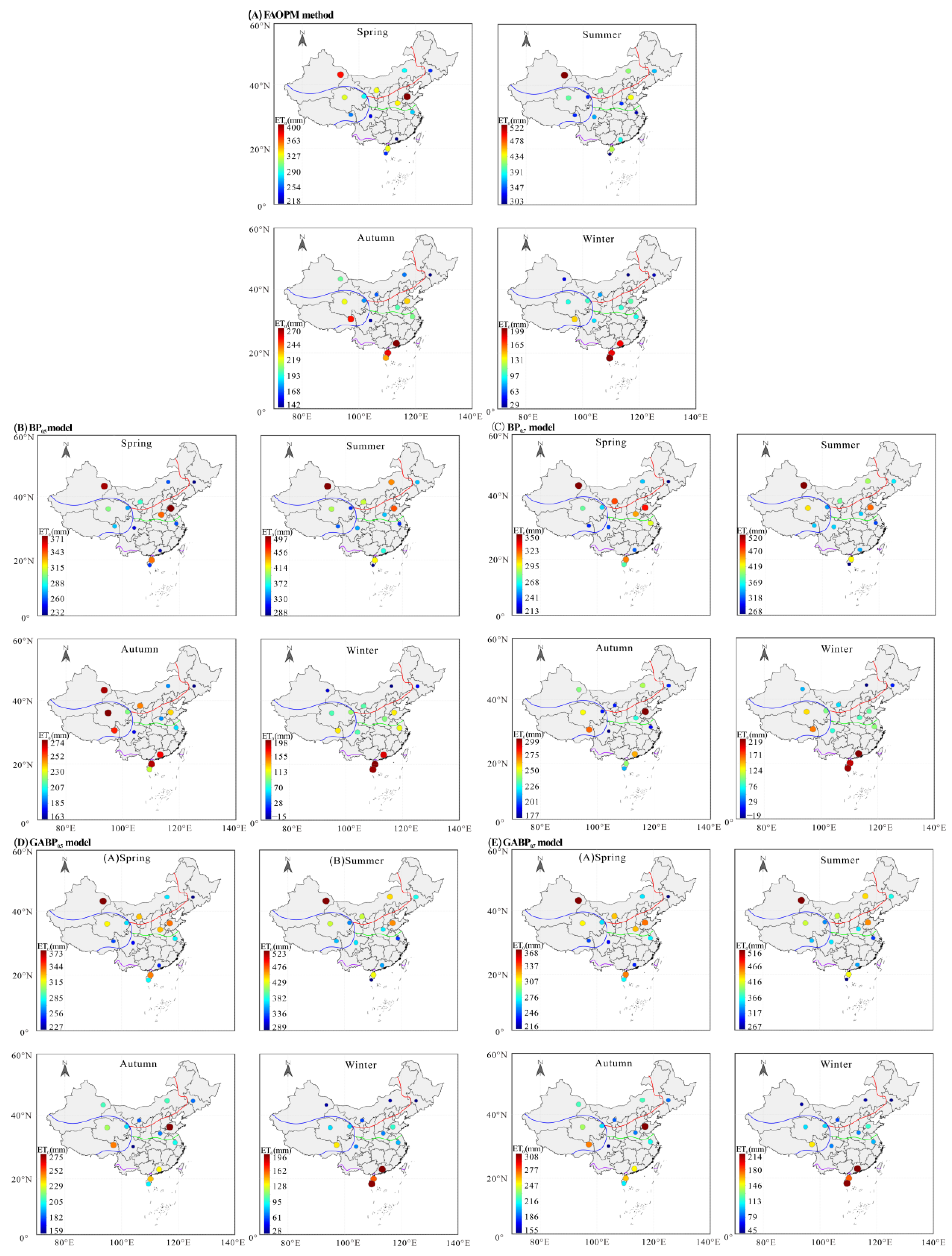
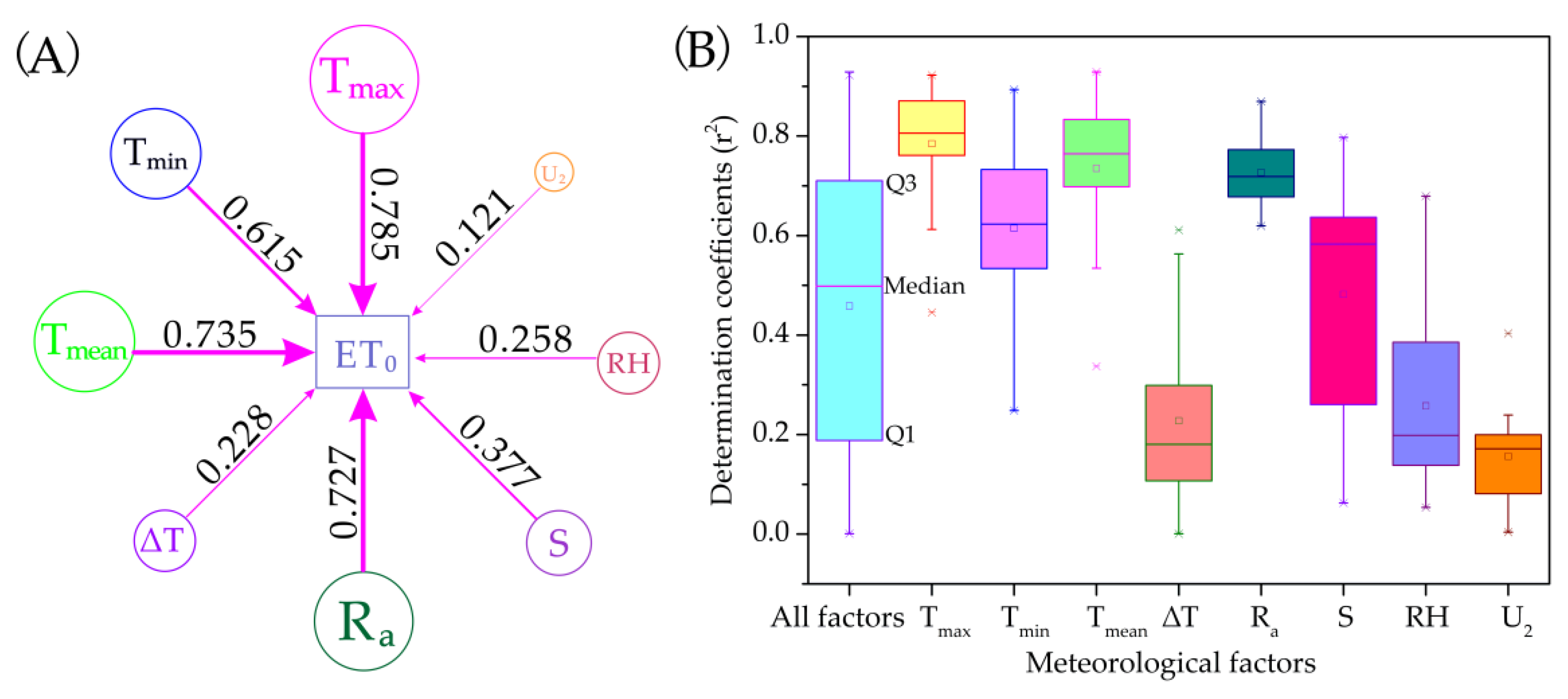


| Climate Type | Station No. | Station Name | Latitude (N) | Longitude (E) | Elevation (m) |
|---|---|---|---|---|---|
| TC | 52,203 | Hami | 42°49′ | 93°31′ | 737.2 |
| TC | 53,463 | Xilin Hot | 43°56′ | 116°10′ | 1065.2 |
| TC | 53,614 | Yinchuan | 38°28′ | 106°12′ | 1110.9 |
| TM | 54,823 | Jinan | 36°36′ | 117°15′ | 170.3 |
| TM | 54,161 | Changchun | 43°54′ | 125°13′ | 236.8 |
| TM | 57,083 | Zhengzhou | 34°43′ | 113°39′ | 110.4 |
| MP | 52,818 | Germu | 36°25′ | 94°55′ | 2807.6 |
| MP | 52,866 | Xining | 36°44′ | 101°45′ | 2295.2 |
| MP | 56,137 | Changdu | 31°09′ | 97°10′ | 3315.5 |
| STM | 59,287 | Guangzhou | 23°13′ | 113°29′ | 70.7 |
| STM | 58,238 | Nanjing | 31°56′ | 118°54′ | 35.2 |
| STM | 57,516 | Chengdu | 30°40′ | 104°04′ | 259.1 |
| TPM | 59,758 | Haikou | 20°03′ | 110°35′ | 18.0 |
| TPM | 59,948 | Sanya | 18°14′ | 109°31′ | 7.1 |
| Station Name | Input Variables Based on r2 > 0.50 | Input Variables Based on r2 > 0.70 | ||||||||||||||
|---|---|---|---|---|---|---|---|---|---|---|---|---|---|---|---|---|
| Tmax | Tmin | Tmean | ∆T | Ra | S | RH | U2 | Tmax | Tmin | Tmean | ∆T | Ra | S | RH | U2 | |
| Hami | √ | √ | √ | √ | √ | √ | √ | √ | √ | |||||||
| Xilin Hot | √ | √ | √ | √ | √ | √ | √ | |||||||||
| Yinchuan | √ | √ | √ | √ | √ | √ | √ | |||||||||
| Jinan | √ | √ | √ | √ | √ | √ | √ | |||||||||
| Changchun | √ | √ | √ | √ | √ | √ | √ | |||||||||
| Zhengzhou | √ | √ | √ | √ | √ | √ | √ | √ | ||||||||
| Germu | √ | √ | √ | √ | √ | √ | √ | √ | ||||||||
| Xining | √ | √ | √ | √ | √ | √ | √ | |||||||||
| Changdu | √ | √ | √ | √ | √ | √ | ||||||||||
| Guangzhou | √ | √ | √ | √ | √ | |||||||||||
| Nanjing | √ | √ | √ | √ | √ | √ | ||||||||||
| Chengdu | √ | √ | √ | √ | √ | √ | √ | √ | √ | |||||||
| Haikou | √ | √ | √ | √ | √ | √ | √ | √ | √ | |||||||
| Sanya | √ | √ | √ | √ | √ | |||||||||||
| Season | Climatic Zone | FAO PM | BP0.5 | BP0.7 | GABP0.5 | GABP0.7 |
|---|---|---|---|---|---|---|
| Spring | TC 1 | 330.8 | 306.6 | 310.6 | 323.4 | 319.0 |
| TM 2 | 327.1 | 314.5 | 285.6 | 303.1 | 289.6 | |
| MP 3 | 292.1 | 283.8 | 258.1 | 284.0 | 275.0 | |
| STM 4 | 244.2 | 248.8 | 259.5 | 247.6 | 248.6 | |
| TPM 5 | 288.4 | 297.7 | 295.9 | 290.5 | 302.1 | |
| Summer | TC | 449.7 | 449.4 | 438.2 | 459.4 | 452.5 |
| TM | 383.4 | 388.1 | 391.1 | 387.3 | 390.9 | |
| MP | 360.9 | 352.9 | 373.9 | 360.3 | 362.4 | |
| STM | 356.9 | 348.6 | 336.6 | 347.7 | 335.0 | |
| TPM | 363.9 | 353.9 | 347.2 | 347.6 | 343.9 | |
| Autumn | TC | 182.4 | 236.4 | 225.7 | 201.2 | 211.3 |
| TM | 190.3 | 197.6 | 240.6 | 202.4 | 230.6 | |
| MP | 216.6 | 250.2 | 239.7 | 238.1 | 238.8 | |
| STM | 207.2 | 212.9 | 210.7 | 217.8 | 207.2 | |
| TPM | 245.3 | 247.5 | 227.1 | 243.4 | 235.2 | |
| Winter | TC | 51.1 | 23.7 | 32.8 | 49.9 | 60.1 |
| TM | 82.8 | 74.7 | 65.8 | 79.7 | 83.5 | |
| MP | 142.2 | 133.2 | 160.5 | 146.1 | 157.0 | |
| STM | 121.7 | 125.5 | 134.1 | 121.3 | 133.1 | |
| TPM | 190.4 | 195.2 | 209.1 | 189.8 | 195.8 |
Publisher’s Note: MDPI stays neutral with regard to jurisdictional claims in published maps and institutional affiliations. |
© 2022 by the authors. Licensee MDPI, Basel, Switzerland. This article is an open access article distributed under the terms and conditions of the Creative Commons Attribution (CC BY) license (https://creativecommons.org/licenses/by/4.0/).
Share and Cite
Qin, A.; Fan, Z.; Zhang, L. Hybrid Genetic Algorithm−Based BP Neural Network Models Optimize Estimation Performance of Reference Crop Evapotranspiration in China. Appl. Sci. 2022, 12, 10689. https://doi.org/10.3390/app122010689
Qin A, Fan Z, Zhang L. Hybrid Genetic Algorithm−Based BP Neural Network Models Optimize Estimation Performance of Reference Crop Evapotranspiration in China. Applied Sciences. 2022; 12(20):10689. https://doi.org/10.3390/app122010689
Chicago/Turabian StyleQin, Anzhen, Zhilong Fan, and Liuzeng Zhang. 2022. "Hybrid Genetic Algorithm−Based BP Neural Network Models Optimize Estimation Performance of Reference Crop Evapotranspiration in China" Applied Sciences 12, no. 20: 10689. https://doi.org/10.3390/app122010689
APA StyleQin, A., Fan, Z., & Zhang, L. (2022). Hybrid Genetic Algorithm−Based BP Neural Network Models Optimize Estimation Performance of Reference Crop Evapotranspiration in China. Applied Sciences, 12(20), 10689. https://doi.org/10.3390/app122010689








